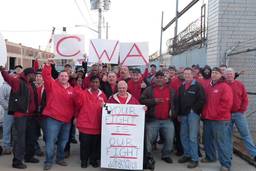On Monday, the Occupation Safety and Health Administration (OSHA) fined a Massachusetts based contractor, P. Gioioso & Sons Inc., $354,000 for safety hazards on work sites involving underground excavation and sewer tunnel building sites that could easily have resulted in deaths.
Sadly, this is not the first time P. Gioioso & Sons has been fined by OSHA for serious violations that could result in the death of workers. Since 2000, the contractor has been fined seven previous times for serious violations that could result in death. Yet OSHA is hamstrung in shutting down the sites of this construction company due to the legislative mandate of the agency. In other words, companies can easily continue to put workers in situations that could result in their death.
In this particular case, while an OSHA inspector was inspecting a trench in Cambridge a section of a wall collapsed while an employee was still in the trench. At a second inspection, OSHA found that the construction trenches’ lacked both vital protections to prevent cave-ins and any means for a worker to safely exit a trench (such as a ladder). Either safety violation could have easily resulted in a workers’ death.
“An unguarded excavation is only seconds away from becoming a grave,” said Martha Kent, OSHA’s New England regional administrator. “While the worker in the Cambridge trench was fortunate not to have been injured when the trench’s sidewall collapsed, worker safety must not and can never be left to fortune.”
OSHA cited P. Gioioso & Sons, which is based just outside of Boston, with four willful violations of federal regulations for its lack of safety equipment. Each violation carried the maximum fine of $70,000. “A willful violation is one committed with intentional knowing or voluntary disregard for the law’s requirement, or with plain indifference to worker safety and health,” the agency says.
The contractor was also cited for five additional serious violations with a fine of $32,000 each for “allowing employees to be exposed to being struck by the counterweight of an excavator” at one of its work sites. A serious violation is when “there is a serious probability that death or serious physical harm could result from a hazard about which the employer knew or should have known.”
Additionally, P. Gioioso & Sons was cited for three repeated violations carrying fines of $42,000 each for trenching and electrical hazards that it had previously been cited for in 2009. The repeated fines qualify the construction contractor for placement in OSHA’s Severe Violator Enforcement Program, which increases the number of follow-up inspections on the company’s construction sites.
In a stern statement, OSHA Director Dr. David Michaels said, “Time and again, this employer has chosen to ignore the law and, by doing so, placed its workers’ lives at risk. Employers who ignore basic, common-sense and legally required safeguards will face substantial fines and consequences.”
The question, though, is whether increased inspections are enough to stop construction companies like P. Gioioso & Sons from putting workers into situations that could potentially kill them.
“Under the Obama Administration, OSHA had done a much better job singling out safety problems and aggressively going after repeat offenders,” says Public Citizen Workplace and Safety Advocate Justin Feldman. “Still, the OSHA Act itself limits the ability of the agency to enforce safety laws. OSHA has a limited ability to issue fines and their fines are significantly lower than other agencies.”
Since the penalties for prosecuting a company for negligent death on the job are so low, few prosecutors attempt to try such cases. The penalty for wrongfully killing a worker on the job is only six months. To put this in perspective, chasing a wild burro onto federal land is a felony that can land you in jail for one year. Since 1970, there have only been 84 cases prosecuted of willful violation of safety rules that resulted in a worker death. During this time, more than 360,000 workers died on the job.
It is also difficult for the agency, part of the Department of Labor, to shut down a safety site on the spot if OSHA inspectors see a problem that could result in a worker’s death. Inspectors have to file for, and receive, an injunction from a federal district court.
While OSHA under the Obama Administration has been trying very hard to enforce workplace safety rules, it is still very limited. “In order for OSHA to do its jobs, we need to give it more resources, more inspectors, the ability to shut down unsafe work sites on the spot, and the ability to levy higher fines,” says Feldman. “The current legislative mandate of OSHA simply does not allow it do that.”

I hope you found this article important. Before you leave, I want to ask you to consider supporting our work with a donation. In These Times needs readers like you to help sustain our mission. We don’t depend on—or want—corporate advertising or deep-pocketed billionaires to fund our journalism. We’re supported by you, the reader, so we can focus on covering the issues that matter most to the progressive movement without fear or compromise.
Our work isn’t hidden behind a paywall because of people like you who support our journalism. We want to keep it that way. If you value the work we do and the movements we cover, please consider donating to In These Times.








